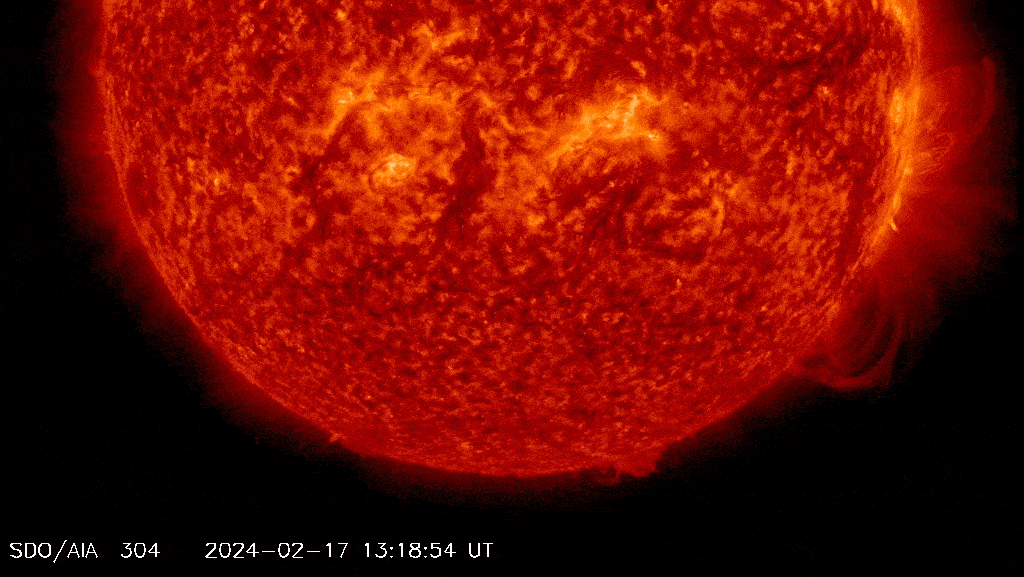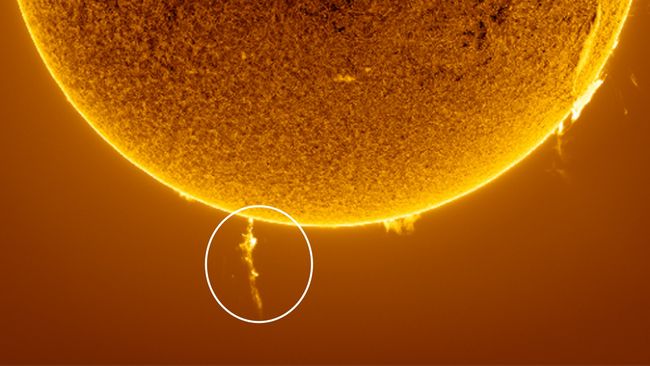The photographer captured a remarkable sight as a rare solar eruption occurred while a ‘magnetic noose’ tightened around the sun’s south pole.
An uncommon event occurred when a solar flare released a large plasma plume from the sun’s southern pole, a location where such stellar eruptions are infrequent. This peculiar occurrence serves as an indication of the approaching solar maximum.
On February 17, an extraordinary event took place on the sun. A massive burst of plasma erupted from the sun’s south pole, an area where solar eruptions rarely occur. This remarkable explosion, captured in remarkable detail by a photographer, serves as a clear indication that the sun is entering its most active phase, known as the solar maximum.
According to Spaceweather.com, the incident involved a solar flare originating from a sunspot near the sun’s south pole. This flare released an enormous column of ionized gas, or plasma, which extended approximately 124,300 miles (200,000 kilometers) above the sun’s surface. To put it into perspective, this towering plume was about 15 times taller than Earth itself. Eventually, the plasma detached from the sun and propelled into space, forming a colossal cloud called a coronal mass ejection (CME).
Eduardo Schaberger Poupeau, an astrophotographer, managed to capture a highly detailed composite image of the plume before it separated from the sun’s surface. Poupeau shared his experience with Spaceweather.com, stating that the plasma column was so immense that he had to rotate the camera to fit it within the frame. He described it as a truly magnificent spectacle.
What makes this stellar explosion even more extraordinary is its origin at the sun’s south pole. Typically, solar flares occur in sunspots located on or near the sun’s equator, rarely near the magnetic poles. This is because the magnetic field at the poles is exceptionally strong, which typically suppresses the formation of sunspots.
Fortunately, due to the orientation of the flare, the resulting coronal mass ejection was directed away from Earth and the other planets that orbit the sun on the same plane.

The polar crown filament (PCF), a loop of magnetism encircling the sun’s magnetic poles, is believed to have triggered the unusual eruption, as stated by Spaceweather.com. This eruption resulted in the release of a plasma plume known as a polar crown prominence (PCP).
During the solar maximum, which is the most active phase of the sun’s approximately 11-year solar cycle, PCPs become more frequent. Spaceweather.com reported that during this phase, PCFs diminish in size, resembling a tightening noose around their respective poles. As these magnetic crowns constrict, they exert pressure on the nearby magnetic fields, increasing the likelihood of explosions.
Experts anticipate that the solar maximum will occur within the next few months, earlier than initially predicted.
As we approach the solar maximum, an increasing number of peculiar phenomena are taking place at the sun’s poles. In February 2023, a PCP detached from the sun and became entangled in a PCF, resulting in a swirling plasma vortex that persisted around the sun’s north pole for eight hours. Additionally, in March of last year, a PCP collapsed inward, leading to the formation of a massive plasma waterfall near the sun’s south pole. This event was followed by the emergence of a colossal rotating plasma plume, referred to as a “solar tornado,” near the solar north pole, which endured for three days.
Do not forget to share your opinion with us to provide you with the best posts !




0 Comments